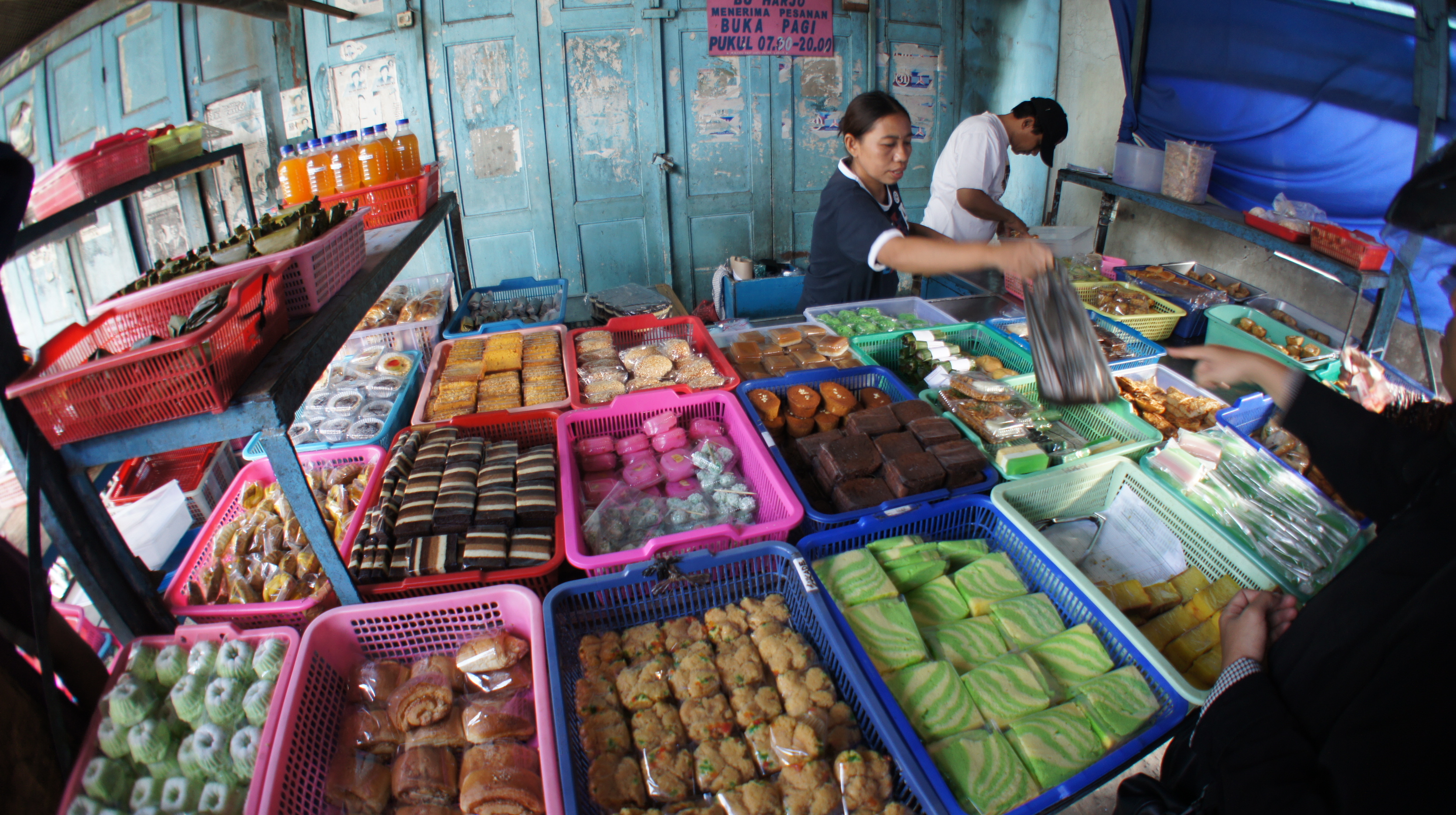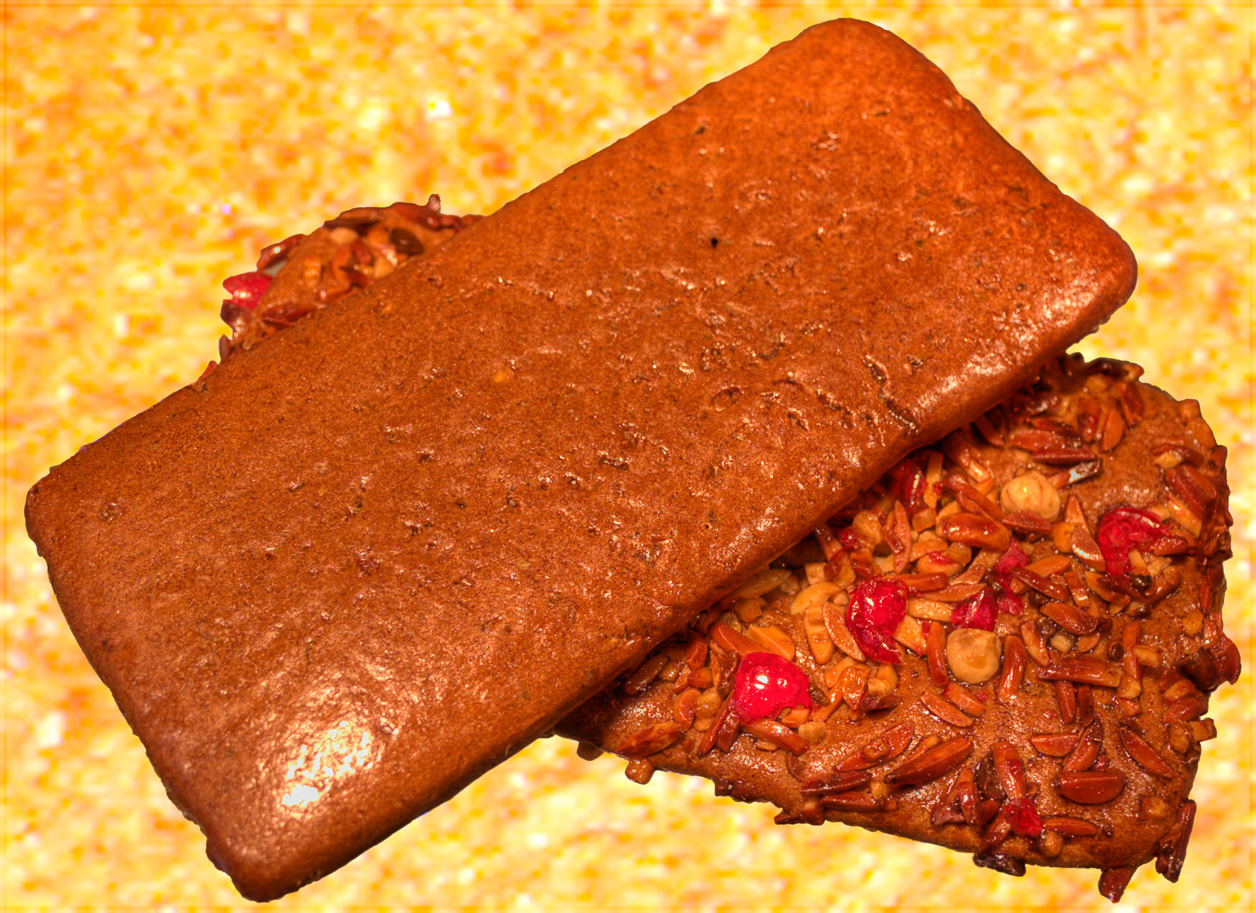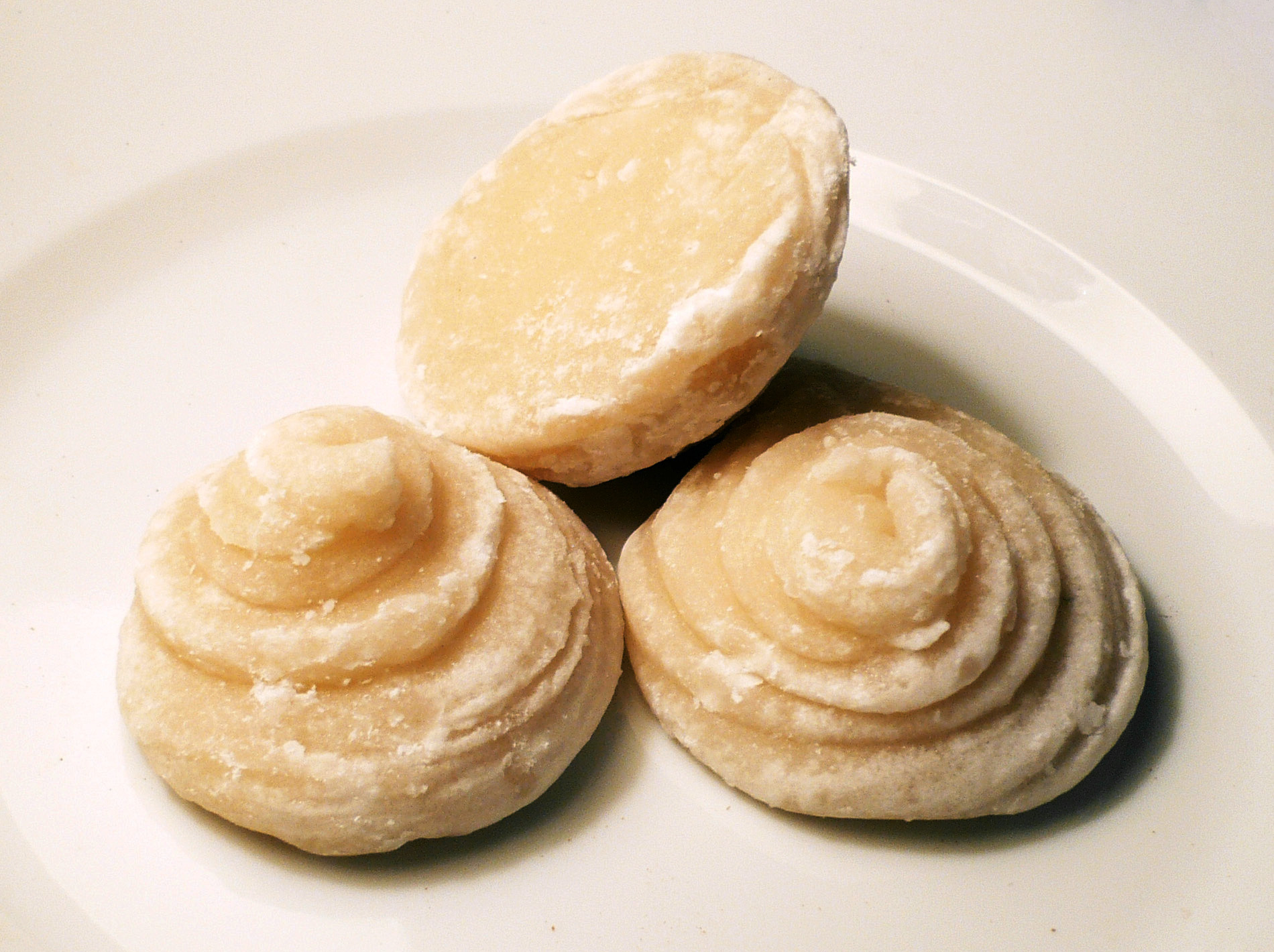|
Kue Bangkit
''Kue bangkit'' is a small biscuit (''kue'' or ''kuih'') that made from sago starch of Malay origin, commonly found in Malaysia and Malaysia. This biscuit has various colours, ranging from white, yellowish to brown, depends on the additional ingredients. In Indonesia, kue bangkit is associated with Malay community of Riau and Riau Islands provinces. While in Malaysia, kuih bangkit is associated with Malays and Nyonya communities. It is one of the typical traditional Malay cookie, mostly associated with ''Hari Raya'' and Chinese New Year. Etymology This coconut sago cookie is called as ''kue bangkit'' in Indonesia, and ''kuih bangkit'' in Malaysia. The term ''bangkit'' in Malay language means "rise" refer to the fact that the biscuit expands twice the size after baking. Ingredients Kue bangkit ingredients consists of sago or tapioca starch, thick coconut milk, sugar, egg yolks, pandan leaf, margarine and salt. Sometimes vanilla extract and ''gula aren'' ( palm sugar) migh ... [...More Info...] [...Related Items...] OR: [Wikipedia] [Google] [Baidu] |
Malaysia
Malaysia ( ; ) is a country in Southeast Asia. The federation, federal constitutional monarchy consists of States and federal territories of Malaysia, thirteen states and three federal territories, separated by the South China Sea into two regions: Peninsular Malaysia and Borneo's East Malaysia. Peninsular Malaysia shares a land and maritime Malaysia–Thailand border, border with Thailand and Maritime boundary, maritime borders with Singapore, Vietnam, and Indonesia. East Malaysia shares land and maritime borders with Brunei and Indonesia, and a maritime border with the Philippines and Vietnam. Kuala Lumpur is the national capital, the country's largest city, and the seat of the Parliament of Malaysia, legislative branch of the Government of Malaysia, federal government. The nearby Planned community#Planned capitals, planned capital of Putrajaya is the administrative capital, which represents the seat of both the Government of Malaysia#Executive, executive branch (the Cabine ... [...More Info...] [...Related Items...] OR: [Wikipedia] [Google] [Baidu] |
Chinese New Year
Chinese New Year is the festival that celebrates the beginning of a New Year, new year on the traditional lunisolar calendar, lunisolar and solar Chinese calendar. In Sinophone, Chinese and other East Asian cultures, the festival is commonly referred to as the Spring Festival () as the Spring (season), spring season in the lunisolar calendar traditionally starts with lichun, the first of the twenty-four solar terms which the festival celebrates around the time of the Chinese New Year. Marking the end of winter and the beginning of the spring season, observances traditionally take place from Chinese New Year's Eve, New Year’s Eve, the evening preceding the first day of the year to the Lantern Festival, held on the 15th day of the year. The first day of Chinese New Year begins on the new moon that appears between 21 January and 20 February. Chinese New Year is one of the most important holidays in Chinese culture, and has strongly influenced Lunar New Year celebrations of its 5 ... [...More Info...] [...Related Items...] OR: [Wikipedia] [Google] [Baidu] |
List Of Indonesian Snacks
This is list of Indonesian snacks. In Indonesian, snacks are called ''kudapan'', ''makanan kecil'' (lit. "small food") or ''makanan ringan'' (lit. "light food"). They might taste savoury or sweet, snack foods are a significant aspect of Indonesian cuisine which is very diverse. Traditional kue snacks — a collection of steamed or fried snacks with rice-flour and coconut sugar-based ingredients, exist in many forms. While traditional crackers of krupuk and kripik chips were also a popular crispy choice. Crackers, chips and crisps Fritters Dumplings Savoury snacks Tofu-based snacks ''Kue basah'' or traditional cakes ''Kue kering'' or cookies and biscuits Pastry, bread and cake Liquid snacks, porridges and beverages Seeds, beans and peanuts See also *Cuisine of Indonesia *Kue *List of Indonesian beverages * List of Indonesian desserts * List of Indonesian dishes *List of Indonesian soups *List of snack foods * List of snack foods by country *Street fo ... [...More Info...] [...Related Items...] OR: [Wikipedia] [Google] [Baidu] |
List Of Indonesian Dishes
This is a list of selected dishes found in Indonesian cuisine. Staple foods Main dishes Curries Meals Soy-based foods Preserved meats Rice dishes and porridges Congees and porridges Rice cake dishes Rice dishes Noodle dishes Soups and stews Salads and vegetable dishes Breads and sandwiches Snacks and starters Savoury snacks Sweet snacks Crackers, chips, and crisps Sweet desserts Cheeses Beverages Seasonings and condiments Common ingredients Spices * Anise (''Adas Manis'') * Asam kandis (dried fruit of ''Garcinia xanthochymus'') * Asam sunti (dried fruit of ''Averrhoa bilimbi'') * Candlenuts (''Kemiri'') * Cardamom (''Kapulaga'') * Chili (''Cabai'') * Cinnamon (''Kayu Manis'') * Clove (Cengkeh) * Coriander seeds (''Ketumbar'') * Cumin seeds (''Jinten'') * Fennel (''Adas'') * Fenugreek (Klabet) * Fingerroot (''Temu Kunci'') * Galangal (''Lengkuas'') * Garcinia atroviridis (''Asam Gelugur'') * Garlic (Bawang putih) * Shallot (Bawang me ... [...More Info...] [...Related Items...] OR: [Wikipedia] [Google] [Baidu] |
List Of Cookies ...
This is a list of notable cookies (American English), also called biscuits (British English). Cookies are typically made with flour, egg, sugar, and some type of shortening such as butter or cooking oil, and baked into a small, flat shape. Cookies Unsorted * Lengua de gato * Peanut butter blossom cookie * Sandies * Stuffed cookie See also * List of baked goods * List of candies * List of cookie sandwiches * List of crackers * List of desserts * List of pastries * List of shortbread biscuits and cookies References {{portalbar, Food, Lists * * Cookies Cookies A cookie is a baked or cooked snack or dessert that is typically small, flat and sweet. It usually contains flour, sugar, egg, and some type of oil, fat, or butter. It may include other ingredients such as raisins, oats, chocolate chips, nuts ... [...More Info...] [...Related Items...] OR: [Wikipedia] [Google] [Baidu] |
Kue Lidah Kucing
Kue lidah kucing ( lit. 'cat tongue '' kue''') is a small Indonesian biscuit ('' kue kering'') shaped somewhat like a cat's tongue (long and flat). They are sweet and crunchy. This cookie is a Dutch-influenced cookie due to the historical tie between Indonesia and the Netherlands. In the Netherlands, this cookie is known as ''kattentong'', and ultimately derived from European cat tongue biscuit. In Indonesia, kue lidah kucing is widely known. This pastry is a special dish in some Indonesian occasion such as Eid ul-Fitr, Christmas and Chinese New Year. See also *Cat tongue * Cookies * Cuisine of Indonesia * Kue * Ladyfinger * List of cookies *List of Indonesian dishes *List of Indonesian snacks This is list of Indonesian snacks. In Indonesian, snacks are called ''kudapan'', ''makanan kecil'' (lit. "small food") or ''makanan ringan'' (lit. "light food"). They might taste savoury or sweet, snack foods are a significant aspect of Indo ... References Cookies Kue ... [...More Info...] [...Related Items...] OR: [Wikipedia] [Google] [Baidu] |
Kue Satu
''Kue satu'' (in West Java and Jakarta) or ''kue koya'' (in Central and East Java) is a popular traditional ''kue kering'' (dry traditional cookie) made of sweet white-colored mung bean powder that crumbles when bitten. It is commonly found as a traditional cookie in Indonesia, especially in Java. In Indonesia, this cookie is often served during festive occasions, such as ''Lebaran'' (Eid al Fitr), '' Natal'' (Christmas), and '' Imlek'' (Chinese new year). It is believed that the cookies were derived from Chinese Peranakan traditional cookies or dry ''kue''. Ingredients and cooking method ''Kue satu'' or ''kue koya'' are made with only four ingredients; mung beans, powdered sugar, vanilla extract, and water. The mung beans are dry-toasted until their skins start to crack, after which the skins are removed. The peeled mung beans are then mashed or ground manually with either a mortar and pestle, or more modern kitchen devices, like a food processor or blender. Then, the powdere ... [...More Info...] [...Related Items...] OR: [Wikipedia] [Google] [Baidu] |
Palm Sugar
Palm sugar is a sweetener derived from any variety of palm tree. Palm sugar is sometimes qualified by the type of palm, as in coconut palm sugar. While sugars from different palms may have slightly different compositions, all are processed similarly and can be used interchangeably. Types The predominant sources of palm sugar are the Palmyra, date, nipa, sugar and coconut palms. The Palmyra palm (''Borassus'' spp.) is grown in Africa, Asia, and New Guinea. The tree has many uses, such as thatching, hatmaking, timber, use as a writing material, and in food products. Palm sugar is produced from sap ('toddy') from the flowers. The date palm has two species, ''Phoenix dactylifera'' and '' P. sylvestris'', and both are sources of palm sugar. ''P. dactylifera'' is common in the Mediterranean and Middle East. ''P. sylvestris'' is native to Asia, mainly Pakistan and India. Date palms are cultivated mainly for dates. Palm sugar is made from the tree's sap. The nipa palm (''Ny ... [...More Info...] [...Related Items...] OR: [Wikipedia] [Google] [Baidu] |
Vanilla
Vanilla is a spice derived from orchids of the genus ''Vanilla (genus), Vanilla'', primarily obtained from pods of the Mexican species, flat-leaved vanilla (''Vanilla planifolia, V. planifolia''). Pollination is required to make the plants produce the fruit from which the vanilla spice is obtained. In 1837, Belgian botanist Charles François Antoine Morren discovered this fact and pioneered a method of artificially pollinating the plant. The method proved financially unworkable and was not deployed commercially. In 1841, Edmond Albius, a 12-year-old enslaved child who lived on the French island of Réunion in the Indian Ocean, discovered that the plant could be hand-pollination, hand-pollinated. Hand-pollination allowed global cultivation of the plant. Noted French botanist and plant collector Jean Michel Claude Richard falsely claimed to have discovered the technique three or four years earlier. By the end of the 20th century, Albius was considered the true discoverer ... [...More Info...] [...Related Items...] OR: [Wikipedia] [Google] [Baidu] |
Margarine
Margarine (, also , ) is a spread used for flavoring, baking, and cooking. It is most often used as a substitute for butter. Although originally made from animal fats, most margarine consumed today is made from vegetable oil. The spread was originally named ''oleomargarine'' from Latin for ''oleum'' (olive oil) and Greek ''margarite'' ("pearl", indicating luster). The name was later shortened to ''margarine''. Margarine consists of a water-in-fat emulsion, with tiny droplets of water dispersed uniformly throughout a fat phase in a stable solid form. While butter is made by concentrating the butterfat of milk through agitation, modern margarine is made through a more intensive processing of refined vegetable oil and water. Per federal regulation, margarine must have a minimum fat content of 80 percent (with a maximum of 16% water) to be labeled as such in the United States, although the term is used informally to describe vegetable-oil-based spreads with lower fat content. In Br ... [...More Info...] [...Related Items...] OR: [Wikipedia] [Google] [Baidu] |
Pandan Leaf
''Pandanus amaryllifolius'' is a tropical plant in the ''Pandanus'' (screwpine) genus, which is commonly known as pandan (; ). It has fragrant leaves which are used widely for flavouring in the cuisines of Southeast Asia and South Asia. Occurrence and habitat ''Pandanus amaryllifolius'' is a true cultigen, and is believed to have been domesticated in ancient times. It is sterile and can only reproduce vegetatively through suckers or cuttings. It was first described from specimens from the Maluku Islands, and the rare presence of male flowers in these specimens may indicate that it is the origin of the species. However, as no other wild specimens have been found, this is still conjecture. The plant is grown widely throughout Southeast Asia and South Asia. Botanical features The characteristic aroma of pandan is caused by the aroma compound 2-acetyl-1-pyrroline, found in the lower epidermal papillae; the compound gives white bread, jasmine rice, and basmati rice (as well as brea ... [...More Info...] [...Related Items...] OR: [Wikipedia] [Google] [Baidu] |
Egg Yolk
Among animals which produce eggs, the yolk (; also known as the vitellus) is the nutrient-bearing portion of the egg whose primary function is to supply food for the development of the embryo. Some types of egg contain no yolk, for example because they are laid in situations where the food supply is sufficient (such as in the body of the host of a parasitoid) or because the embryo develops in the parent's body, which supplies the food, usually through a placenta. Reproductive systems in which the mother's body supplies the embryo directly are said to be matrotrophic; those in which the embryo is supplied by yolk are said to be lecithotrophic. In many species, such as all birds, and most reptiles and insects, the yolk takes the form of a special storage organ constructed in the reproductive tract of the mother. In many other animals, especially very small species such as some fish and invertebrates, the yolk material is not in a special organ, but inside the egg cell. As sto ... [...More Info...] [...Related Items...] OR: [Wikipedia] [Google] [Baidu] |





.jpg)

